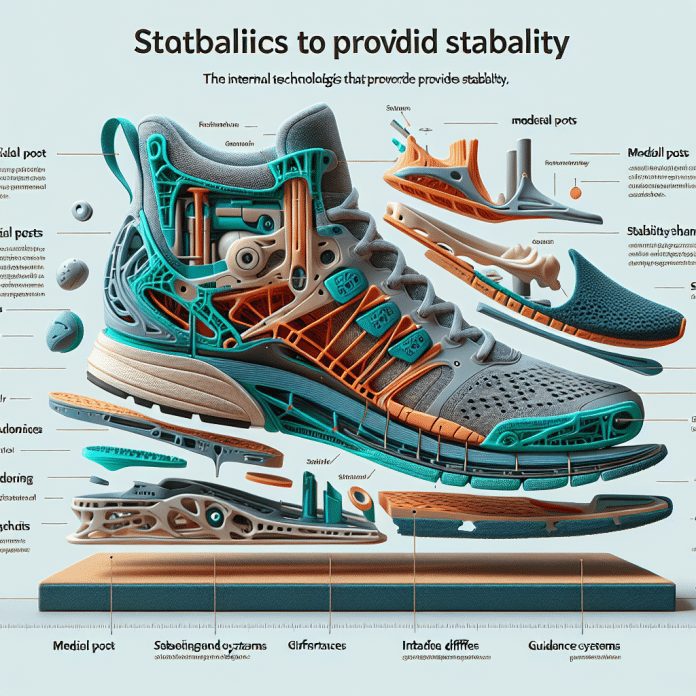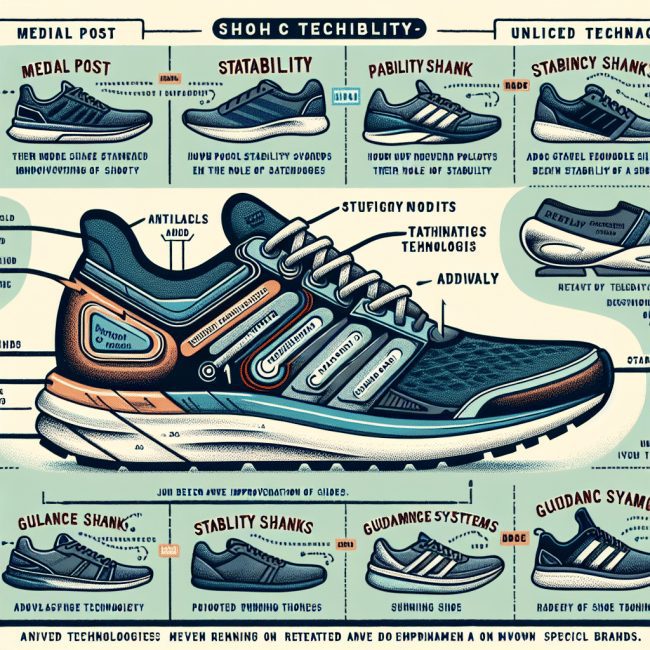In your quest to find the perfect running shoes, it’s important to understand the technologies that contribute to stability. Whether you’re an avid runner or just getting started, having stable footwear can make a world of difference in your performance and overall comfort. From innovative cushioning systems to advanced midsole designs, these technologies work together to provide the necessary support and stability that runners need. But which technologies should you look out for? Let’s explore some of the key advancements that help improve stability in running shoes.
Review contents
1. Arch Support
Arch support plays a vital role in providing stability and preventing overpronation while running. There are different types of arch support available in running shoes, each catering to different foot types and needs.
1.1 Rigid Arch Support
Rigid arch support refers to a firm structure built into the midsole of the shoe to provide maximum support to high-arched feet. This type of arch support helps distribute the weight evenly across the foot, reducing the risk of rolling or twisting during running. It offers a stable platform for the foot, enhancing overall stability and preventing excessive pronation.
1.2 Dynamic Arch Support
On the other hand, dynamic arch support is designed for runners with low to medium arches. It consists of cushioning materials and flexible components that offer a responsive and adaptive support system. This type of arch support allows the shoe to adapt to the natural movement of the foot, providing a more personalized and comfortable fit.
1.3 Medial Post
Medial posts are commonly found in stability running shoes and are designed to control excessive inward rolling of the foot, known as overpronation. They are usually made of denser materials and located on the inner side of the midsole. Medial posts provide additional support and help maintain proper alignment of the foot, reducing the risk of injuries caused by overpronation.
2. Heel Counter
The heel counter is a structural component located around the back of the shoe’s upper heel area. It plays a crucial role in providing stability and preventing excessive heel movement.
2.1 External Heel Counter
An external heel counter is a more traditional approach to heel stability. It is typically made of sturdy materials, such as rigid plastic or carbon fiber, that wrap around the heel from the outside. This type of heel counter provides excellent support and helps lock the heel in place, preventing excessive sideways motion and ensuring a stable landing.
2.2 Internal Heel Counter
In recent years, internal heel counters have gained popularity due to their sleeker design and improved comfort. Instead of being visible from the outside, they are integrated within the shoe’s upper material. Internal heel counters are typically made of supportive and lightweight materials like foam, providing a secure fit without compromising on cushioning or flexibility.
3. Midsole Cushioning
Midsole cushioning directly impacts the comfort and stability of running shoes. It absorbs shock, provides cushioning, and contributes to a smooth and stable running experience. Here are three common midsole cushioning technologies found in running shoes:
3.1 EVA Foam
EVA (Ethylene-Vinyl Acetate) foam is a lightweight and highly cushioned material commonly used in midsoles. It offers excellent shock absorption and energy return, improving overall comfort and reducing the impact on joints during running. EVA foam is known for its durability and responsiveness, making it a popular choice for runners seeking a stable and comfortable ride.
3.2 PU Foam
PU (Polyurethane) foam is another midsole cushioning material that provides enhanced durability and stability compared to EVA foam. It offers a slightly firmer and more resilient feel, ensuring optimal support and responsiveness, especially for runners needing additional stability. PU foam is known for its ability to maintain its cushioning properties over an extended period, making it suitable for long-distance runners.
3.3 TPU Foam
TPU (Thermoplastic Polyurethane) foam combines the qualities of EVA and PU foam. It offers a balance of cushioning and responsiveness while providing excellent stability and support. TPU foam tends to be more durable and retains its cushioning properties even after prolonged use. This makes it an ideal choice for runners looking for a stable and long-lasting midsole material.
4. Stability Plates
Stability plates are thin inserts located between the midsole and outsole of running shoes. They provide additional support and torsional stability, preventing excessive twisting of the shoe during movement.
4.1 TPU Stability Plate
TPU stability plates are made of thermoplastic polyurethane and are commonly used in stability running shoes. They offer excellent torsional rigidity and help control excessive foot movement during the gait cycle. TPU stability plates provide stability, especially for runners with overpronation tendencies, and promote a more efficient and stable running stride.
4.2 Carbon Fiber Plate
Carbon fiber plates have gained considerable attention in recent years due to their lightweight and highly rigid nature. Although primarily associated with enhancing propulsion and speed, carbon fiber plates also contribute to stability by reducing excessive flexion of the shoe’s midsole. This reduction in flexion helps maintain a stable platform during toe-off, providing added stability for runners.
5. Torsional Rigidity
Torsional rigidity refers to a shoe’s resistance to twisting. It is an essential aspect of stability in running shoes, as excessive torsional movement can hinder proper foot alignment and increase the risk of injuries.
5.1 Torsion System
A torsion system is a technological feature integrated into the midsole of running shoes to enhance torsional rigidity. It usually consists of a thermoplastic bridge or shank that connects the forefoot and heel areas. This system allows for controlled movement while limiting excessive twisting, providing stability and support during the heel-to-toe transition.
5.2 Reinforced Shank
Some running shoes incorporate a reinforced shank, typically made of firm plastic or carbon fiber, in the midsole. This shank enhances the shoe’s torsional rigidity by preventing excessive twisting of the midfoot. It increases stability and provides a solid base for foot movement, promoting a more efficient gait cycle and reducing the risk of instability-related injuries.
6. Toe Box Reinforcements
The toe box area of running shoes is prone to wear and tear, especially during more aggressive running activities. Toe box reinforcements help enhance the shoe’s durability and protect the toes from impacts.
6.1 Overlays
Overlays are additional layers of material that are strategically placed over the toe box area to reinforce it. These overlays help protect the toe box from abrasion, extending the shoe’s lifespan and maintaining its stability. They also provide added support and structure, preventing the toe box from collapsing during push-off and ensuring a secure and stable fit.
6.2 TPU Toe Caps
TPU toe caps, made of thermoplastic polyurethane, are another type of reinforcement commonly used in running shoes. They provide extra protection to the toes and reinforce the front of the shoe. TPU toe caps help prevent accidental impacts or stubbing of the toes, maintaining the stability and structural integrity of the shoe, especially during trail running or challenging terrains.
7. Lateral Support
Lateral support is crucial for maintaining stability and preventing excessive sideways movement during running. It helps reduce the risk of ankle sprains and provides a more secure and stable running experience.
7.1 Midfoot Overlays
Midfoot overlays are structural components integrated into the upper of running shoes, specifically designed to enhance lateral support. These overlays extend from the midfoot area to the upper sides of the shoe, providing a snug and secure fit. Midfoot overlays offer stability and prevent the foot from shifting sideways, ensuring proper alignment and reducing the risk of instability-related injuries.
7.2 TPU Bands
TPU bands are another technology used to enhance lateral support in running shoes. These bands are located on the lateral sides of the shoe’s upper and provide targeted support to resist excessive foot movement during running. TPU bands offer a balance between flexibility and stability, allowing for natural foot motion while preventing overpronation or supination, ultimately enhancing stability and reducing the risk of injuries.
8. Pronation Control
Pronation control technologies aim to prevent excessive inward rolling of the foot, providing stability and promoting proper foot alignment.
8.1 Dual-Density Midsole
Dual-density midsoles consist of two different densities of foam materials integrated into the midsole. The softer foam is usually located on the inner side of the shoe, while the firmer foam is placed on the outer side to control pronation. This design helps redistribute the forces applied to the foot, reducing the risk of overpronation and enhancing stability during the gait cycle.
8.2 Varus Wedge
A varus wedge is a technology that involves adding a wedged or angled component to the midsole of the shoe. It is typically placed on the inner side of the midsole to counteract overpronation. The varus wedge provides added stability by aligning the foot and ankle in a more optimal position, reducing excessive inward rolling and promoting a more efficient and stable running stride.
9. Outsole Configuration
The outsole of running shoes plays a crucial role in providing stability and traction. Different configurations and materials can enhance stability, especially during various running surfaces and conditions.
9.1 Decoupled Heel
A decoupled heel refers to an outsole design where the heel is separated or isolated from the rest of the outsole. This design allows for independent movement of the heel, reducing excessive pronation and promoting a smoother and more stable heel-to-toe transition. A decoupled heel enhances stability by providing a more controlled and efficient footstrike.
9.2 Multi-Density Rubber
Using multi-density rubber in the outsole can significantly enhance stability. By strategically placing firmer rubber compounds in high-impact areas and softer rubber compounds in less critical areas, the shoe can provide the right balance of stability, cushioning, and traction. The multi-density rubber outsole offers increased durability, grip, and overall stability, ensuring a secure and stable running experience in various conditions.
10. Upper Materials
The upper materials of running shoes contribute to their overall stability, durability, and comfort. Different materials offer varying levels of ventilation, support, and flexibility.
10.1 Synthetic Mesh
Synthetic mesh is a widely used upper material in running shoes due to its breathability, flexibility, and lightweight nature. It allows for adequate airflow, keeping the feet cool and dry during running. Synthetic mesh also provides a snug and supportive fit, ensuring stability while allowing the foot to move naturally.
10.2 Engineered Mesh
Engineered mesh is an advanced upper material that combines the breathability of mesh with improved structure and support. It consists of different densities and patterns of synthetic fibers, offering targeted ventilation and stability where needed. Engineered mesh provides a secure fit, enhances overall stability, and reduces the risk of foot shifting during running.
10.3 Flyknit
Flyknit is a revolutionary upper material developed by Nike. It is a knitted fabric made from synthetic yarns, offering a seamless and sock-like fit. Flyknit upper materials provide exceptional breathability, flexibility, and lightweight support. It conforms to the shape of the foot, providing a secure and stable fit, ultimately enhancing the overall stability and comfort of the running shoe.
In conclusion, various technologies and features contribute to improving stability in running shoes. From arch support and heel counters to midsole cushioning and outsole configurations, each aspect plays a role in enhancing stability, preventing injuries, and providing a comfortable and stable running experience. Whether you have high arches, overpronation tendencies, or simply strive for a more stable ride, there are running shoe technologies available to cater to your specific needs and support your running endeavors.










